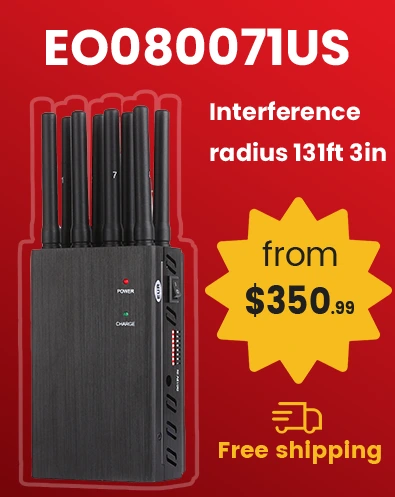Cell Phone Jammers and Blocker Signal in Italy
Cell phone signal jamming is a growing concern in many countries. If you are planning to jam your cell phone signal in Italy, it is essential to know the frequency bands used by the country's mobile operators. In this article, we will introduce you to Italy's mobile operators and the frequencies they currently use.
In Italy, all modern communication standards 3G, 4G and GSM are available. At the same time, GSM operates at 900-1800 MHz frequencies. In addition, the network can be used to triangulate cell phone towers. Before traveling, you should first make sure that a cell phone signal jammer works in this country. Many people send a special call called a squillo. This is a greeting in the form of a sound signal.
3G operates using the HSPA+ standard at 2.1 GHz, which provides users with high signal quality. At the same time, in overpopulated areas, the speed may be reduced due to excessive load. 4G operates according to the LTE standard. At the same time, the network is still actively developing. The low cost of mobile Internet is also a big advantage. Everyone can buy a local SIM card.
Now all the big cities have 3G, the speed is fast enough, the small towns may have some communication problems, but the speed is fast enough, you can surf the Internet for free, the price of mobile network and communication services is relatively low, customers don't have to worry, at the same time, you have to pay not only for traffic, but also for Internet time.
There are many local operators in Italy, including Vodafone, Wind, Tim and Tre. They provide services at roughly the same price and provide consistent coverage. There are also some virtual telecom operators that operate with the help of large equipment.
All modern operators use standard communication protocols. To connect to mobile communications, you need to use the services of one of the mobile operators. You need a passport and a unique code to sign a contract, but tourists don't need it.
Mobile operators in Italy
There are four main mobile operators in Italy. Here are their specific names:
TIM (Telecom Italia Mobile)
TIM is one of the largest telecom operators in Italy and a traditional telecom giant in Italy. It mainly provides fixed-line, mobile communications, broadband Internet, TV and enterprise solutions for markets such as Italy and Brazil. TIM's 4G LTE network covers the whole country, and has launched 5G networks in major cities such as Rome, Milan, Florence and Naples, and plans to further expand 5G coverage.
TIM's operating frequency:
- 2G network (GSM) frequency
- 900 MHz and 1800 MHz: 2G network supports traditional voice and SMS services. Although 2G network has been gradually reduced, it is still available in some remote areas.
- 3G network (UMTS) frequency
- 2100 MHz: 3G network frequency band, providing higher data transmission rate and voice services. However, with the popularization of 4G and 5G networks, 3G services are gradually reduced.
- 4G LTE network frequency
- 800 MHz: Mainly used in wide coverage areas to ensure wide coverage of network signals in cities and villages.
- 1800 MHz and 2600 MHz: Used to increase network capacity, especially in high-density areas such as cities, to ensure high-speed and large-capacity data transmission.
- 5G network frequencies
- 700 MHz and 3700 MHz: Main 5G frequency bands, providing wide coverage and higher data transmission speeds, especially for high-density areas.
- 26 GHz: High frequency band, providing extremely high transmission speeds and capacity, suitable for hot spots and dense urban environments.
Mobile Virtual Network Operators (MVNOs)
The mobile virtual network operator (MVNO) market in Italy is active, mainly including PosteMobile, Kena Mobile, Ho. Mobile and Fastweb Mobile. These MVNOs provide low-cost and flexible packages to meet the needs of different types of users by renting network resources from TIM, Vodafone and Wind Tre.
Frequency bands used by operators in Italy
Each of these operators uses a different frequency band to provide mobile phone services to its users. Here are the main frequency bands used by operators in Italy:
900 MHz band: This band is used by all operators in Italy to provide 2G (GSM) and 3G (UMTS) networks. This is a low frequency band with wide coverage but slower data flow.
1800 MHz band: This band is used by all operators to run 2G and 4G (LTE) networks. It provides higher data flow compared to the 900 MHz band.
2100 MHz band: This band is used by all operators for 3G networks.
800MHz band: This band is used by operators for 4G networks.
2600MHz band: This band is used by operators for 4G networks.
Italy blocks cell phone signals
Italy's telecommunications market is dominated by TIM, Vodafone, Wind Tre and Iliad, with good 4G coverage, mainly in the 800 MHz, 1800 MHz and 2600 MHz bands. 5G development is accelerating, mainly using the 3.7 GHz and 26 GHz millimeter wave bands.
Now that we know the frequency bands used by Italian mobile operators, we can answer the question of which band should be blocked to eliminate mobile phone signals. To effectively block mobile phone signals in Italy, you should consider blocking the 900 MHz, 1800 MHz, 2100 MHz, 800 MHz and 2600 MHz bands. This will cover the 2G, 3G and 4G networks used by Italian operators.







